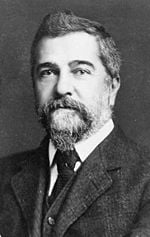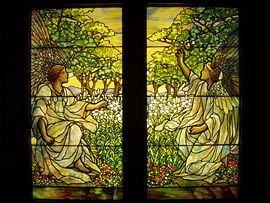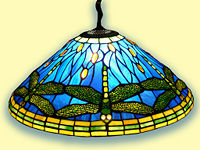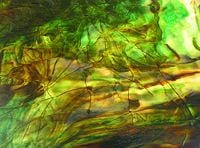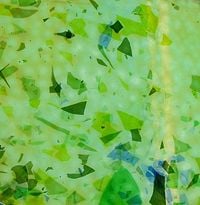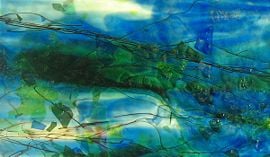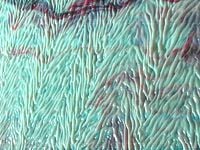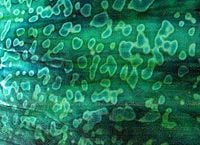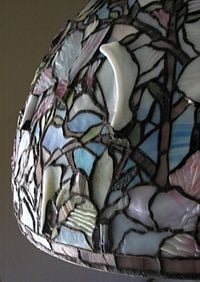Difference between revisions of "Tiffany Glass" - New World Encyclopedia
m (Robot: Category fix) |
Rosie Tanabe (talk | contribs) m |
||
| (17 intermediate revisions by 6 users not shown) | |||
| Line 1: | Line 1: | ||
| − | + | {{Images OK}}{{submitted}}{{approved}}{{Paid}}{{copyedited}} | |
| − | '' | + | [[Image:Girl with Cherry Blossoms - Tiffany Glass & Decorating Company, c. 1890.JPG|thumb|280px|''Girl with Cherry Blossoms'' illustrates many types of glass employed by Tiffany including elaborate polychrome painting of the face, ''drapery glass'' for the dress, ''opalescent glass'' for the blossoms, ''streaky glass'' in the border, ''fracture-streamer glass'' in the background, and what may be ''iridescent glass'' in the beads.]] |
| − | + | '''Tiffany glass''' is the generic name describing the many and varied types of glass developed and produced by [[Louis Comfort Tiffany]] (1848-1933), one of the most famous stained-glass artists of the [[United States]], who is remembered not only for his windows but for decorative glass objects, in particular, so-called [[Tiffany lamps]]. | |
| − | + | The coloration that Tiffany, originally a painter, saw in medieval Roman and Syrian glass convinced him that contemporary glass could be much improved. The "rich tones" of the glass the artist sought would be able to transmit texture and rich colors, and thus, he developed a type of glass he called ''Favrile''. In his [[experiments]], Tiffany developed a wider variety of [[colors]] and [[textures]], more so than anywhere else in the [[world]]. In particular, he found that the look of common glass jars was more beautiful in [[color]] and quality than stained glass since they contained impurities, such as [[oxides]] of [[iron]]. | |
| + | {{toc}} | ||
| + | Tiffany's material of choice was [[opalescent]] glass, which had the ability of changing color under transmitted light, rather than the quality of having several colors present. The range of glasses created by Tiffany is based on his use of opalescent glass in such a variety of colors and textures so as to create a totally unique style of stained glass. Today, Tiffany's glasswork is highly valued by art collectors. | ||
| − | Tiffany | + | ==Tiffany's career in glass== |
| + | [[Image:Louis Comfort Tiffany c. 1908.jpg|thumb|150px|Louis Comfort Tiffany]] | ||
| + | Louis Comfort Tiffany started out as a painter. In 1865, Tiffany traveled to Europe, and in London, he visited the Victoria and Albert Museum, whose extensive collection of Roman and Syrian glass made a deep impression on him. He admired the coloration of medieval glass and was convinced that the quality of contemporary glass left much to be desired. Tiffany wanted the glass, itself, to transmit texture and rich colors. In his own words, the "Rich tones are due in part to the use of pot metal full of impurities, and in part to the uneven thickness of the glass, but still more because the glass maker of that day abstained from the use of paint." He developed a type of glass which he called ''Favrile''. | ||
| − | Tiffany | + | Tiffany became interested in [[glass]] making around 1875, and worked at several glasshouses in Brooklyn between then and 1878. He was also an interior designer, and his interest turned toward the creation of stained glass. He opened his own studio and glass foundry because he was unable to find the types of glass that he desired in interior decoration. Joining with [[Samuel Colman]] and [[Lockwood de Forest]], he formed Louis Comfort Tiffany and Associated American Artists. Tiffany's leadership and talent, as well as from his father's money and connections, led this business to thrive. His inventiveness both as a designer of windows and as a producer of the material with which to create them was to become renowned. |
| + | Tiffany later decided to establish his own glassmaking firm to concentrate on art in glass. The first Tiffany Glass Company was incorporated on December 1, 1885, which in 1902, became known as the [[Tiffany Studios]]. | ||
| + | [[Image:The Holy City.jpg|thumb|left|300px|''The Holy City'' (1905) – [[John of Patmos|St. John]]'s vision on the isle of [[Patmos]]. Having 58 panels, this window is said to be one of the largest made by the Tiffany Studios. It is located at [[Brown Memorial Presbyterian Church]] ([[Baltimore, Maryland]]), which has 11 Tiffany windows.]] | ||
| − | + | Tiffany initially used cheap jelly jars and bottles in his work, because they had the special quality that finer glass lacked. He continued his [[experiments]], trying to develop a wider variety of [[colors]] and [[textures]] of glass than was available anywhere in the [[world]]. He discovered that the glass in common claret bottles and preserve jars was more beautiful in [[color]] and quality than any existing stained glass, since they contained [[oxides]] of [[iron]] and other impurities. | |
| − | + | When he was unable to convince fine glassmakers to leave the impurities in, he began making his own glass. Tiffany used [[opalescent]] glass in a variety of colors and textures to create a unique style of stained glass. This can be contrasted with the method of painting in glass paint or enamels on colorless glass, which had been the dominant method of creating stained glass for several hundred years in Europe. | |
| − | The term "opalescent glass" is commonly used to describe glass where more than one | + | |
| + | Use of the colored glass to create stained-glass pictures was motivated by the ideals of the [[Arts and Crafts movement]], led by [[William Morris]] in [[England]], which was in large part a reaction to the "soulless" man-made production of the [[Industrial Revolution]]. Fellow artist and glassmaker [[John La Farge]] was one of Tiffany's chief competitors, along with Oliver Kimberly and Frank Duffner of The [[Duffner and Kimberly]] Company, in this new American style of stained glass. Tiffany, La Farge, and Kimberly had learned their craft at the same glasshouses in Brooklyn in the late-1870s. | ||
| + | |||
| + | In 1893, Tiffany built a new factory, called the Stourbridge Glass Company, later called Tiffany Glass Furnaces, which was located in [[Corona, Queens]], [[New York]]. In 1893, his company introduced the term, "[[Favrile]]" in conjunction with his first production of blown glass at his new glass factory. Some early examples of his lamps were exhibited in the [[1893 World's Fair]] in [[Chicago]]. | ||
| + | |||
| + | He trademarked ''[[Favrile]]'' (from the old French word for "handmade") on November 13, 1894. He later used this word to apply to all of his glass, enamel, and pottery. Tiffany's first commercially produced lamps date from around 1895. Much of his company's production was in making stained-glass windows and [[Tiffany lamps]], but his company designed a complete range of interior decorations. At its peak, his factory employed more than 300 artisans. | ||
| + | |||
| + | Tiffany highlighted his glassmaking skills in the design of his own house, the 84-room [[Laurelton Hall]], in [[Oyster Bay, New York|Oyster Bay]], [[Long Island]], completed in 1905. Later this estate was donated to his foundation for art students along with 60 acres of land, sold in 1949, and was destroyed by a fire in 1957. | ||
| + | |||
| + | The [[Charles Hosmer Morse Museum of American Art]] in [[Winter Park, Florida]] houses the world's most comprehensive collection of the works of Tiffany, including [[jewelry]], [[pottery]], [[painting]]s, [[art glass]], [[leaded-glass]] windows, lamps, and the chapel interior he designed for the 1893 [[World's Columbian Exposition]] in Chicago. After the close of the exposition, a generous benefactor purchased the entire chapel for installation in the crypt of the [[Cathedral of Saint John the Divine, New York]] in New York City. | ||
| + | |||
| + | ==Types of Tiffany glass== | ||
| + | [[Image:Two Angels - Tiffany Studios, c. 1910.JPG|thumb|270px|''Two Angels'', 1910]] | ||
| + | ===Opalescent glass=== | ||
| + | The term "opalescent glass" is commonly used to describe glass where more than one color is present, being fused during the manufacture, as against "flashed" glass in which two colors may be laminated, or silver stained glass where a solution of silver nitrate is superficially applied, turning red glass to orange and blue glass to green. Some opalescent glass was used by several stained-glass studios in England from the 1860s and 1870s onwards, notably Heaton, Butler, and Bayne. Its use became increasingly common. Opalescent glass is the basis for the range of glasses created by Tiffany. The use of the term "opalescent" is actually a misnomer. [[Opalescence]] actually refers to the quality of changing color under transmitted light, rather than the quality of having several colors present. A rare example of true opalescent glass is the [[Ancient Roman|Roman]] Lycurgus cup in the [[British Museum]]. | ||
===Favrile glass=== | ===Favrile glass=== | ||
| − | Tiffany [[patent|patented]] ''Favrile glass'' in 1880. The [[trade name]] "Favrile" was derived from the French word, ''fabrile'' | + | [[Image:Tiffany dragonfly hg.jpg|thumb|200px|Tiffany dragonfly lampshade]] |
| − | + | [[Image:streamerglass.jpg|thumb|right|200px|Streamer glass]] | |
| − | Favrile glass often has a distinctive characteristic that is common in some glass from Classical antiquity: | + | Tiffany [[patent|patented]] ''Favrile glass'' in 1880. The [[trade name]] "Favrile" was derived from the French word, ''fabrile,'' meaning handcrafted. Favrile glass often has a distinctive characteristic that is common in some glass from Classical antiquity: It possesses a superficial [[iridescence]]. This iridescence causes the surface to shimmer, but also causes a degree of opacity. This iridescent effect of the glass was obtained by mixing different colors of glass together while hot. |
According to Tiffany: | According to Tiffany: | ||
| − | <blockquote> | + | <blockquote>Favrile glass is distinguished by brilliant or deeply toned colors, usually iridescent like the wings of certain American butterflies, the necks of pigeons and peacocks, and the wing covers of various beetles.</blockquote> |
| − | |||
===Streamer glass=== | ===Streamer glass=== | ||
| − | + | '''Streamer glass''' refers to a sheet of glass with a pattern of glass strings affixed to its surface. Tiffany made use of such textured glass to represent, for example, twigs, branches, and grass. | |
| − | |||
| − | |||
| + | Streamers are prepared from very hot molten glass, gathered at the end of a punty (pontil) that is rapidly swung back and forth and stretched into long, thin strings that rapidly cool and harden. These hand-stretched streamers are pressed on the molten surface of sheet glass during the rolling process, and become permanently fused. | ||
===Fracture glass=== | ===Fracture glass=== | ||
| − | |||
[[Image:fractureglass.jpg|thumb|right|200px|Fracture glass]] | [[Image:fractureglass.jpg|thumb|right|200px|Fracture glass]] | ||
| − | '''Fracture glass''' refers to a sheet of glass with a pattern of irregularly shaped, thin glass wafers affixed to its surface. | + | '''Fracture glass''' refers to a sheet of glass with a pattern of irregularly shaped, thin glass wafers affixed to its surface. Tiffany made use of such textured glass to represent, for example, foliage seen from a distance. |
| − | |||
| − | |||
| + | The irregular glass wafers, called "fractures," are prepared from very hot, colored molten glass, gathered at the end of a blowpipe. A large bubble is forcefully blown until the walls of the bubble rapidly stretch, cool and harden. The resulting glass bubble has paper-thin walls and is immediately shattered into shards. These hand-blown shards are pressed on the surface of the molten-glass sheet during the rolling process, to which they become permanently fused. | ||
===Fracture-streamer glass=== | ===Fracture-streamer glass=== | ||
| + | [[Image:fracturestreamerglass.jpg|thumb|right|270px|Fracture-streamer glass]]'''Fracture-streamer glass''' refers to a sheet of glass with a pattern of glass strings, and irregularly shaped, thin glass wafers, affixed to its surface. | ||
| − | + | These hand-stretched streamers and hand blown shards are pressed on the surface of the molten- glass sheet during the rolling process, to which they become permanently fused. | |
| − | |||
| − | |||
| − | |||
| − | |||
| − | |||
| − | These hand-stretched streamers and hand blown shards are pressed on the surface of the molten glass sheet during the rolling process, to which they become permanently fused. | ||
===Ripple glass=== | ===Ripple glass=== | ||
| + | [[Image:herringbonerippleglass.jpg|thumb|right|200px|Herringbone ripple glass]]'''Ripple glass''' refers to a sheet of [[texture]]d glass with marked surface waves. Tiffany made use of such textured glass to represent water or leaf veins. | ||
| − | + | The texture is created during the glass sheet-forming process. A sheet is formed from molten glass with a roller that spins on itself, while traveling forward. Normally the roller spins at the same speed as its own forward motion, and the resulting sheet has a smooth surface. In the manufacture of rippled glass, the roller spins faster than its own forward motion. The rippled effect is retained as the glass cools. | |
| − | |||
| − | The texture is created during the glass sheet-forming process. | ||
| − | |||
===Ring mottle glass=== | ===Ring mottle glass=== | ||
[[Image:ringmottleglass.jpg|thumb|right|200px|Ring mottle glass]] | [[Image:ringmottleglass.jpg|thumb|right|200px|Ring mottle glass]] | ||
| − | '''Ring mottle glass''' refers to sheet glass with a pronounced mottle created by localized, heat-treated opacification and crystal-growth dynamics. | + | '''Ring mottle glass''' refers to sheet glass with a pronounced mottle created by localized, heat-treated opacification and crystal-growth dynamics. Ring mottle glass was invented by [[Louis Comfort Tiffany]] in the early twentieth century. Tiffany's distinctive style exploited glass containing a variety of motifs such as those found in ring mottle glass, and he relied minimally on painted details. |
| − | When Tiffany Studio closed in 1928, the secret formula for making ring mottle glass was forgotten and lost. | + | When Tiffany Studio closed in 1928, the secret formula for making ring mottle glass was forgotten and lost. Ring mottle glass was "re-invented" in the late sixties by Eric Lovell. |
| − | |||
| − | Ring mottle glass was "re-invented" in the late sixties by Eric Lovell | ||
Traditionally used for organic details on leaves and other natural elements, ring mottles also find a place in contemporary work when abstract patterns are desired. | Traditionally used for organic details on leaves and other natural elements, ring mottles also find a place in contemporary work when abstract patterns are desired. | ||
| Line 69: | Line 76: | ||
===Drapery glass=== | ===Drapery glass=== | ||
[[Image:Draperyglassmagnoliashade.jpg|thumb|right|200px|Drapery glass incorporated in a reproduction of Tiffany's "Magnolia" lampshade]] | [[Image:Draperyglassmagnoliashade.jpg|thumb|right|200px|Drapery glass incorporated in a reproduction of Tiffany's "Magnolia" lampshade]] | ||
| − | '''Drapery glass''' refers to a sheet of heavily folded [[glass]] that suggests fabric folds. Tiffany made | + | '''Drapery glass''' refers to a sheet of heavily folded [[glass]] that suggests fabric folds. Tiffany made abundant use of drapery glass in [[ecclesiastic]]al stained-glass windows to add a three-dimensional effect to flowing robes and angel wings, and to imitate the natural coarseness of magnolia petals. |
| − | |||
| − | |||
| − | |||
| − | |||
| − | |||
| − | |||
| − | + | The making of drapery glass requires skill and experience. A small diameter hand-held roller is manipulated forcefully over a sheet of molten glass to produce heavy ripples, while folding and creasing the entire sheet. The ripples become rigid and permanent as the glass cools. Each sheet produced from this artisanal process is unique. | |
| − | == References == | + | ==References== |
| − | + | *Clough-Eaton, Connie. ''Tiffany Windows Stained Glass Pattern Book.'' Dover Publications, 1997. ISBN 978-0486298535 | |
| − | + | *Duncan, Alastair. ''Masterworks of Louis Comfort Tiffany.'' Harry N. Abrams, 1998. ISBN 978-0810981188 | |
| − | + | *Lee, Lawrence, George Seddon, and Francis Stephens. ''Stained Glass.'' Spring Books, 1976. ISBN 0-600-56281-6 | |
| + | *Steeg, Moise S. ''Tiffany Favrile Art Glass.'' Schiffer Publishing, 2000. ISBN 978-0764302077 | ||
| − | |||
[[Category:Art, music, literature, sports and leisure]] | [[Category:Art, music, literature, sports and leisure]] | ||
{{credit|109259578}} | {{credit|109259578}} | ||
Latest revision as of 22:27, 8 December 2015
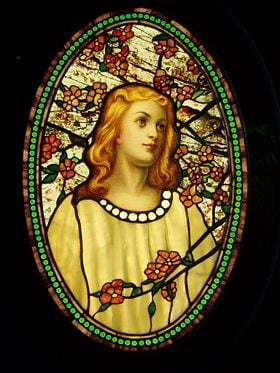
Tiffany glass is the generic name describing the many and varied types of glass developed and produced by Louis Comfort Tiffany (1848-1933), one of the most famous stained-glass artists of the United States, who is remembered not only for his windows but for decorative glass objects, in particular, so-called Tiffany lamps.
The coloration that Tiffany, originally a painter, saw in medieval Roman and Syrian glass convinced him that contemporary glass could be much improved. The "rich tones" of the glass the artist sought would be able to transmit texture and rich colors, and thus, he developed a type of glass he called Favrile. In his experiments, Tiffany developed a wider variety of colors and textures, more so than anywhere else in the world. In particular, he found that the look of common glass jars was more beautiful in color and quality than stained glass since they contained impurities, such as oxides of iron.
Tiffany's material of choice was opalescent glass, which had the ability of changing color under transmitted light, rather than the quality of having several colors present. The range of glasses created by Tiffany is based on his use of opalescent glass in such a variety of colors and textures so as to create a totally unique style of stained glass. Today, Tiffany's glasswork is highly valued by art collectors.
Tiffany's career in glass
Louis Comfort Tiffany started out as a painter. In 1865, Tiffany traveled to Europe, and in London, he visited the Victoria and Albert Museum, whose extensive collection of Roman and Syrian glass made a deep impression on him. He admired the coloration of medieval glass and was convinced that the quality of contemporary glass left much to be desired. Tiffany wanted the glass, itself, to transmit texture and rich colors. In his own words, the "Rich tones are due in part to the use of pot metal full of impurities, and in part to the uneven thickness of the glass, but still more because the glass maker of that day abstained from the use of paint." He developed a type of glass which he called Favrile.
Tiffany became interested in glass making around 1875, and worked at several glasshouses in Brooklyn between then and 1878. He was also an interior designer, and his interest turned toward the creation of stained glass. He opened his own studio and glass foundry because he was unable to find the types of glass that he desired in interior decoration. Joining with Samuel Colman and Lockwood de Forest, he formed Louis Comfort Tiffany and Associated American Artists. Tiffany's leadership and talent, as well as from his father's money and connections, led this business to thrive. His inventiveness both as a designer of windows and as a producer of the material with which to create them was to become renowned.
Tiffany later decided to establish his own glassmaking firm to concentrate on art in glass. The first Tiffany Glass Company was incorporated on December 1, 1885, which in 1902, became known as the Tiffany Studios.
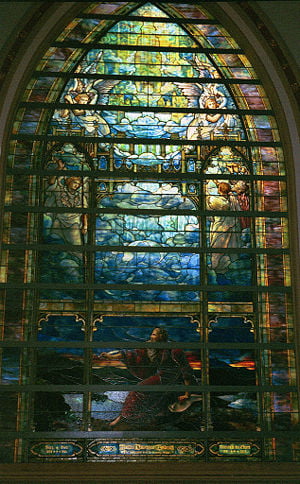
Tiffany initially used cheap jelly jars and bottles in his work, because they had the special quality that finer glass lacked. He continued his experiments, trying to develop a wider variety of colors and textures of glass than was available anywhere in the world. He discovered that the glass in common claret bottles and preserve jars was more beautiful in color and quality than any existing stained glass, since they contained oxides of iron and other impurities.
When he was unable to convince fine glassmakers to leave the impurities in, he began making his own glass. Tiffany used opalescent glass in a variety of colors and textures to create a unique style of stained glass. This can be contrasted with the method of painting in glass paint or enamels on colorless glass, which had been the dominant method of creating stained glass for several hundred years in Europe.
Use of the colored glass to create stained-glass pictures was motivated by the ideals of the Arts and Crafts movement, led by William Morris in England, which was in large part a reaction to the "soulless" man-made production of the Industrial Revolution. Fellow artist and glassmaker John La Farge was one of Tiffany's chief competitors, along with Oliver Kimberly and Frank Duffner of The Duffner and Kimberly Company, in this new American style of stained glass. Tiffany, La Farge, and Kimberly had learned their craft at the same glasshouses in Brooklyn in the late-1870s.
In 1893, Tiffany built a new factory, called the Stourbridge Glass Company, later called Tiffany Glass Furnaces, which was located in Corona, Queens, New York. In 1893, his company introduced the term, "Favrile" in conjunction with his first production of blown glass at his new glass factory. Some early examples of his lamps were exhibited in the 1893 World's Fair in Chicago.
He trademarked Favrile (from the old French word for "handmade") on November 13, 1894. He later used this word to apply to all of his glass, enamel, and pottery. Tiffany's first commercially produced lamps date from around 1895. Much of his company's production was in making stained-glass windows and Tiffany lamps, but his company designed a complete range of interior decorations. At its peak, his factory employed more than 300 artisans.
Tiffany highlighted his glassmaking skills in the design of his own house, the 84-room Laurelton Hall, in Oyster Bay, Long Island, completed in 1905. Later this estate was donated to his foundation for art students along with 60 acres of land, sold in 1949, and was destroyed by a fire in 1957.
The Charles Hosmer Morse Museum of American Art in Winter Park, Florida houses the world's most comprehensive collection of the works of Tiffany, including jewelry, pottery, paintings, art glass, leaded-glass windows, lamps, and the chapel interior he designed for the 1893 World's Columbian Exposition in Chicago. After the close of the exposition, a generous benefactor purchased the entire chapel for installation in the crypt of the Cathedral of Saint John the Divine, New York in New York City.
Types of Tiffany glass
Opalescent glass
The term "opalescent glass" is commonly used to describe glass where more than one color is present, being fused during the manufacture, as against "flashed" glass in which two colors may be laminated, or silver stained glass where a solution of silver nitrate is superficially applied, turning red glass to orange and blue glass to green. Some opalescent glass was used by several stained-glass studios in England from the 1860s and 1870s onwards, notably Heaton, Butler, and Bayne. Its use became increasingly common. Opalescent glass is the basis for the range of glasses created by Tiffany. The use of the term "opalescent" is actually a misnomer. Opalescence actually refers to the quality of changing color under transmitted light, rather than the quality of having several colors present. A rare example of true opalescent glass is the Roman Lycurgus cup in the British Museum.
Favrile glass
Tiffany patented Favrile glass in 1880. The trade name "Favrile" was derived from the French word, fabrile, meaning handcrafted. Favrile glass often has a distinctive characteristic that is common in some glass from Classical antiquity: It possesses a superficial iridescence. This iridescence causes the surface to shimmer, but also causes a degree of opacity. This iridescent effect of the glass was obtained by mixing different colors of glass together while hot.
According to Tiffany:
Favrile glass is distinguished by brilliant or deeply toned colors, usually iridescent like the wings of certain American butterflies, the necks of pigeons and peacocks, and the wing covers of various beetles.
Streamer glass
Streamer glass refers to a sheet of glass with a pattern of glass strings affixed to its surface. Tiffany made use of such textured glass to represent, for example, twigs, branches, and grass.
Streamers are prepared from very hot molten glass, gathered at the end of a punty (pontil) that is rapidly swung back and forth and stretched into long, thin strings that rapidly cool and harden. These hand-stretched streamers are pressed on the molten surface of sheet glass during the rolling process, and become permanently fused.
Fracture glass
Fracture glass refers to a sheet of glass with a pattern of irregularly shaped, thin glass wafers affixed to its surface. Tiffany made use of such textured glass to represent, for example, foliage seen from a distance.
The irregular glass wafers, called "fractures," are prepared from very hot, colored molten glass, gathered at the end of a blowpipe. A large bubble is forcefully blown until the walls of the bubble rapidly stretch, cool and harden. The resulting glass bubble has paper-thin walls and is immediately shattered into shards. These hand-blown shards are pressed on the surface of the molten-glass sheet during the rolling process, to which they become permanently fused.
Fracture-streamer glass
Fracture-streamer glass refers to a sheet of glass with a pattern of glass strings, and irregularly shaped, thin glass wafers, affixed to its surface.
These hand-stretched streamers and hand blown shards are pressed on the surface of the molten- glass sheet during the rolling process, to which they become permanently fused.
Ripple glass
Ripple glass refers to a sheet of textured glass with marked surface waves. Tiffany made use of such textured glass to represent water or leaf veins.
The texture is created during the glass sheet-forming process. A sheet is formed from molten glass with a roller that spins on itself, while traveling forward. Normally the roller spins at the same speed as its own forward motion, and the resulting sheet has a smooth surface. In the manufacture of rippled glass, the roller spins faster than its own forward motion. The rippled effect is retained as the glass cools.
Ring mottle glass
Ring mottle glass refers to sheet glass with a pronounced mottle created by localized, heat-treated opacification and crystal-growth dynamics. Ring mottle glass was invented by Louis Comfort Tiffany in the early twentieth century. Tiffany's distinctive style exploited glass containing a variety of motifs such as those found in ring mottle glass, and he relied minimally on painted details.
When Tiffany Studio closed in 1928, the secret formula for making ring mottle glass was forgotten and lost. Ring mottle glass was "re-invented" in the late sixties by Eric Lovell.
Traditionally used for organic details on leaves and other natural elements, ring mottles also find a place in contemporary work when abstract patterns are desired.
Drapery glass
Drapery glass refers to a sheet of heavily folded glass that suggests fabric folds. Tiffany made abundant use of drapery glass in ecclesiastical stained-glass windows to add a three-dimensional effect to flowing robes and angel wings, and to imitate the natural coarseness of magnolia petals.
The making of drapery glass requires skill and experience. A small diameter hand-held roller is manipulated forcefully over a sheet of molten glass to produce heavy ripples, while folding and creasing the entire sheet. The ripples become rigid and permanent as the glass cools. Each sheet produced from this artisanal process is unique.
ReferencesISBN links support NWE through referral fees
- Clough-Eaton, Connie. Tiffany Windows Stained Glass Pattern Book. Dover Publications, 1997. ISBN 978-0486298535
- Duncan, Alastair. Masterworks of Louis Comfort Tiffany. Harry N. Abrams, 1998. ISBN 978-0810981188
- Lee, Lawrence, George Seddon, and Francis Stephens. Stained Glass. Spring Books, 1976. ISBN 0-600-56281-6
- Steeg, Moise S. Tiffany Favrile Art Glass. Schiffer Publishing, 2000. ISBN 978-0764302077
Credits
New World Encyclopedia writers and editors rewrote and completed the Wikipedia article in accordance with New World Encyclopedia standards. This article abides by terms of the Creative Commons CC-by-sa 3.0 License (CC-by-sa), which may be used and disseminated with proper attribution. Credit is due under the terms of this license that can reference both the New World Encyclopedia contributors and the selfless volunteer contributors of the Wikimedia Foundation. To cite this article click here for a list of acceptable citing formats.The history of earlier contributions by wikipedians is accessible to researchers here:
The history of this article since it was imported to New World Encyclopedia:
Note: Some restrictions may apply to use of individual images which are separately licensed.
